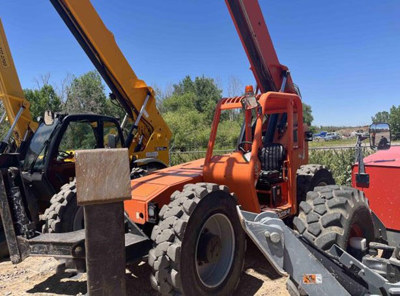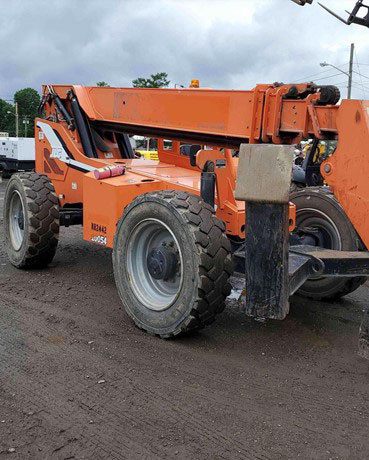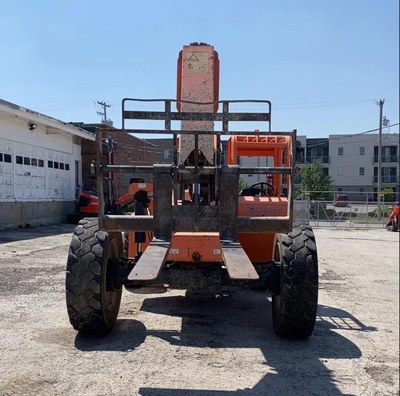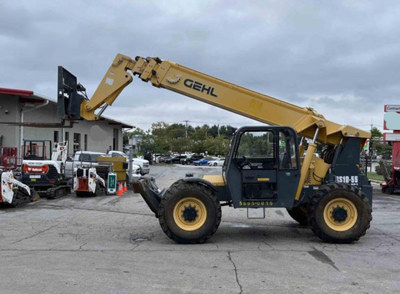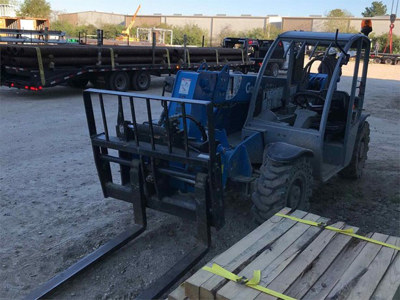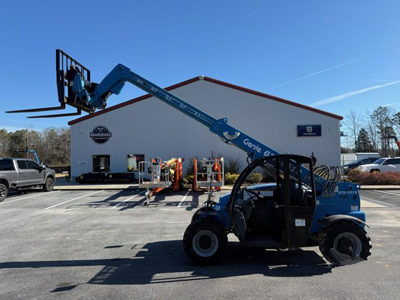What is a Telehandler Used For?
Telehandlers are heavy-duty construction equipment used to lift, move, or place heavy materials or equipment. Suitable for construction sites, factories, warehouses, and agricultural settings, telehandlers can seamlessly transition into excavating and digging machines with the correct attachment. Telehandlers agility makes them able to access inaccessible areas with ease.
What is Another Name for Telehandler?
Telehandlers are machines with many capabilities that commonly go by other names. Forklift, front-end loader, loader, cherry picker, boom lift, and zoom boom are all common terms referring to a telehandler.
Shop Popular Brands of Telehandlers for Sale on FleetNow:
What Should I Look for When Shopping for a Telehandler for Sale?
When shopping for a telehandler, there are several key factors to consider to ensure you choose the right equipment for your needs:
Lift Capacity and Reach: Determine the maximum weight the telehandler needs to lift and the required reach or horizontal extension.
Height and Lift Height: Consider the maximum height you need to reach and the lift height of the telehandler.
Attachments and Versatility: Evaluate the availability of attachments such as forks, buckets, jibs, and platforms that can be used with the telehandler.
Terrain and Tire Type: Assess the terrain conditions where the telehandler will be used, such as rough terrain, indoor, or outdoor applications. Choose a telehandler with appropriate tires (pneumatic, foam-filled, or solid) and features like 4-wheel drive or rough terrain capability for optimal performance.
Operator Comfort and Safety: Consider features that enhance operator comfort and safety, such as ergonomic controls, spacious cab design, visibility enhancements, safety interlock systems, and stability monitoring systems.
Power Source: Decide whether you need a diesel-powered or electric-powered telehandler based on your application and environmental regulations. Diesel telehandlers typically offer higher power and are suitable for outdoor use, while electric telehandlers are quieter and emission-free, ideal for indoor applications.
Advantages to Buying a Used Telehandler for Sale
Telehandlers, being multifunctional machines, can come at a hefty price. Opting for a used machine will lower the cost of acquiring a telehandler. Lightly used machines come with maintenance and inspection reports, ensuring they perform comparably to new telehandlers. Finding a slightly used machine in your area might be cheaper than shipping a new telehandler to the job site. Buying a used telehandler also will lower the insurance cost on the machine, which will also lower the operating cost. Buying a used machine will also help you buy attachments or upgrades with the money saved by purchasing a used machine.
When Should I Consider Buying a New Telehandler for Sale?
If a telehandler is going to play a major role in your day-to-day operations, you should consider a new telehandler. If you are also looking for a machine with the newest technology and improved safety features a brand-new machine will check all those boxes. With proper maintenance and affordability in mind, a new telehandler might be the ideal choice. If you are looking for a machine that still has a warranty, then a new one is worth considering.
How Much Does it Cost to Buy a Telehandler?
The most common Telehandler size, 5,000 pounds, will cost $70,000–$80,000 new, depending on options like whether the cab open or enclosed, heat, etc. 5K Telehandlers from 2012–2015 cost anywhere between $35,000–$55,000. 10,000-pound Telehandlers are another popular size. New units are very limited. Model year 2013–2017 10k Telehandlers can be purchased for $32,000–$85,000.
How Much Does It Cost to Ship a Telehandler?
You can expect to pay around $4.25 per mile to ship a Telehandler as part of a partial load. Costs will typically be higher on the east coast than on the west coast. In February 2023, it will cost $2,400 to ship an 8K Telehandler 565 miles from Wisconsin to Ohio. Shopping for a telehandler for sale consider its location. Size and weight play factors into the cost of shipping a telehandler when getting a telehandler to its desired location.
How Many Hours Does a Telehandler Last?
Well-maintained telehandlers should not need to be remanufactured before 5,000 hours. Many units can reliably work for 10,000 hours. Telehandler with regular maintenance and proper care, telehandlers can last for thousands of hours before requiring replacements. Ninety-five percent of telehandlers for sale on FleetNow have under 5,000 hours.


What are the Most Reliable Telehandler Brands for Sale?
Several telehandler brands are well-regarded for their quality, reliability, and performance. Some of the best telehandler brands include:
SkyTrak: SkyTrak, a brand of JLG Industries, produces reliable and durable telehandlers suitable for various applications, including construction, agriculture, and industrial operations. SkyTrak telehandlers are known for their rugged construction and high lift capacities.
Genie: Genie, a subsidiary of Terex Corporation, produces a diverse lineup of telehandlers known for their reliability, productivity, and ease of operation. Their telehandlers feature excellent lift capacities, reach heights, and attachment compatibility.
JLG: JLG telehandlers are highly regarded within the industry for their performance, reliability, and customer satisfaction.
Gehl: Gehl, a subsidiary of Manitou Group, is known for producing good quality telehandlers with features that make them suitable for various applications.
JCB: JCB is a renowned manufacturer of construction equipment, including telehandlers. They offer a wide range of telehandlers with innovative features, robust construction, and excellent lift capacities.
See more on telehandlers here:
What’s the Difference Between a Telehandler and a Forklift?
Forklifts tend to load and move items vertically, typically inside. A telehandler maneuvers items side to side, forwards and backwards, reaching out and extending further than a forklift. Some telehandlers are equipped with stabilizing legs or outriggers to help counterbalance the load balance. Telehandlers can work in various terrains due to the machine’s great stability. They also have a wide range of attachments, which makes a telehandler a flexible machine for your fleet.
Check out this video for more information:
Recent Equipment News
MEC MME25 Review: Specs, Features & Industry Perspective
MEC MME25 Review: Specs, Features & Industry [...]
Construction Equipment Trends 2025: Inside Q1–Q2 Demand & What It Means for You
Table of Contents Top 10 Categories Q1 vs [...]
FleetNow Announces Elijah Dollarhide as 2025 Construct Your Future Scholarship Winner
FleetNow Announces Elijah Dollarhide as Construct Your Future Scholarship [...]


